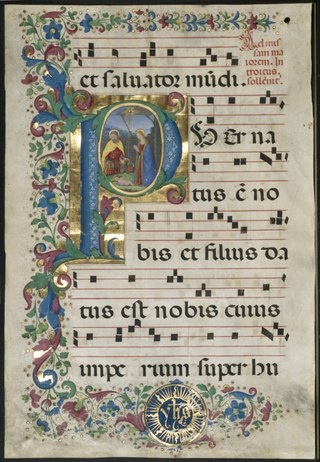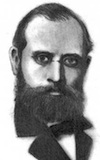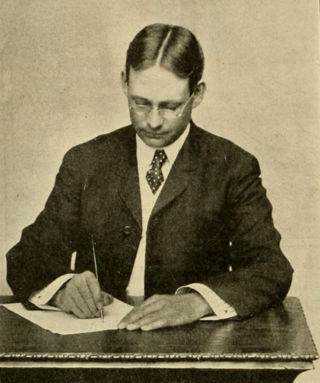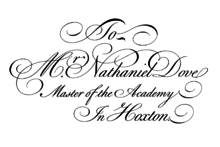
Calligraphy is a visual art related to writing and is the design and execution of lettering with a pen, ink brush, or other writing instrument. Contemporary calligraphic practice can be defined as "the art of giving form to signs in an expressive, harmonious, and skillful manner".

Penmanship is the technique of writing with the hand using a writing instrument. Today, this is most commonly done with a pen, or pencil, but throughout history has included many different implements. The various generic and formal historical styles of writing are called "hands" while an individual's style of penmanship is referred to as "handwriting".

The Palmer Method of penmanship instruction was developed and promoted by Austin Palmer in the late 19th and early 20th centuries. It was largely created as a simplified style of the "Spencerian method", which had been the major standardized system of handwriting since the 1840s. The Palmer Method soon became the most popular handwriting system in the United States.

Handwriting is the writing done with a writing instrument, such as a pen or pencil, in the hand. Handwriting includes both printing and cursive styles and is separate from formal calligraphy or typeface. Because each person's handwriting is unique and different, it can be used to verify a document's writer. The deterioration of a person's handwriting is also a symptom or result of several different diseases. The inability to produce clear and coherent handwriting is also known as dysgraphia.

Cursive is any style of penmanship in which characters are written joined in a flowing manner, generally for the purpose of making writing faster, in contrast to block letters. It varies in functionality and modern-day usage across languages and regions; being used both publicly in artistic and formal documents as well as in private communication. Formal cursive is generally joined, but casual cursive is a combination of joins and pen lifts. The writing style can be further divided as "looped", "italic", or "connected".

Islamic calligraphy is the artistic practice of handwriting and calligraphy, in the languages which use Arabic alphabet or the alphabets derived from it. It includes Arabic, Persian, Ottoman, and Urdu calligraphy. It is known in Arabic as khatt Arabi, which translates into Arabic line, design, or construction.

Italic script, also known as chancery cursive and Italic hand, is a semi-cursive, slightly sloped style of handwriting and calligraphy that was developed during the Renaissance in Italy. It is one of the most popular styles used in contemporary Western calligraphy.

The D'Nealian Method is a style of writing and teaching handwriting based on Latin script which was developed between 1965 and 1978 by Donald N. Thurber (1927–2020) in Michigan, United States. Building on his experience as a primary school teacher, Thurber aimed to make the transition from print writing to cursive easier for learners.

Charles Paxton Zaner was an American calligrapher, pen artist, and teacher of penmanship.

Secretary hand or script is a style of European handwriting developed in the early sixteenth century that remained common in the sixteenth and seventeenth centuries for writing English, German, Welsh and Gaelic.

Getty-Dubay Italic is a modern teaching script for handwriting based on Latin script, developed in 1976 in Portland, Oregon, by Barbara Getty and Inga Dubay with the aim of allowing learners to make an easier transition from print writing to cursive.

Spencerian script is a script style based on Copperplate script that was used in the United States from approximately 1850 to 1925, and was considered the American de facto standard writing style for business correspondence prior to the widespread adoption of the typewriter. Spencerian script, an American form of cursive handwriting, was also widely integrated into the school system as an instructional method until the "simpler" Palmer Method replaced it. President James A. Garfield called the Spencerian script, "the pride of our country and the model of our schools."

A nib is the part of a quill, dip pen, fountain pen, ball point or stylus which comes into contact with the writing surface in order to deposit ink. Different types of nibs vary in their purpose, shape and size, as well as the material from which they are made.
A Flex nib is a type of fountain pen nib that can create different line widths. Due to its non-rigid structure, a flex nib allows a writer to control line width by adjusting the pressure of the pen on paper. Increased pressure will cause the two tines of the nib to separate slightly, allowing more ink to flow onto the page. A lighter grip will allow the tines to remain close together and produce a thinner line. Range of line widths from a fountain pen is limited; however, the most flexible nibs can produce a width about six times greater than that of a regular nib. The most flexible nibs are sometimes known among collectors as "wet noodles".
The International Association of Master Penmen, Engrossers and Teachers of Handwriting (IAMPETH) is an international association for practicing and preserving the arts of calligraphy, engrossing and penmanship. IAMPETH was founded in 1949.

Michael Sull is an IAMPETH master penman and author living in Mission, Kansas, United States. An expert on penmanship, he was Ronald Reagan's calligrapher after his presidency and is known worldwide for his skill and teaching ability. He regularly teaches handwriting, calligraphy, and engrossing programs throughout the United States, Europe and Asia.
Barchowsky Fluent Handwriting (BFH) is a modern teaching script for handwriting based on Latin script, developed in the late 20th century by Nan Jay Barchowsky in Maryland, US, with the aim of allowing learners to make an easier transition from print writing to cursive.

Edward Clarence Mills (1873–1962) was an American master penman and educator, noted for the Business Writing style of cursive handwriting.

A teaching script is a sample script that serves as a visual orientation for learning to write by hand. In the sense of a guideline or a prototype, it supports the demanding process of developing handwriting skills and abilities in a visual and illustrative way.

The Zaner-Bloser is a teaching script for handwriting based on Latin script as well as a system of penmanship instruction, which originated around 1904 at the Zanerian College of Penmanship in Columbus, Ohio. Charles P. Zaner (1864–1918) and Elmer W. Bloser (1865–1929), originally a Spencerian Method instructor, developed their teaching script with the aim of allowing learners an easier transition from print writing to cursive. The Zaner-Bloser Method first teaches block letters and then cursive in order to enable written expression as quickly as possible and thus develop the ability to write. Material relating to the method of instruction practised by Zaner and Bloser is still being published by the Zaner-Bloser Company.















